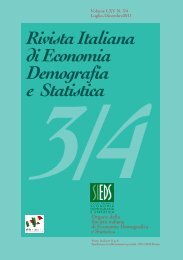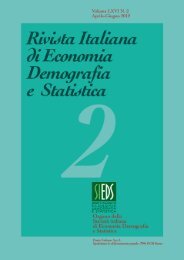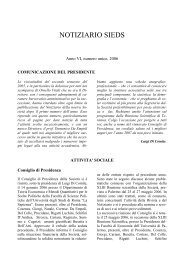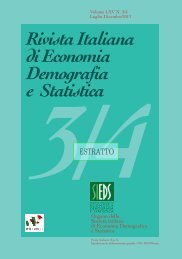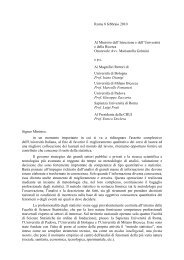rivista italiana di economia demografia e statistica - Sieds
rivista italiana di economia demografia e statistica - Sieds
rivista italiana di economia demografia e statistica - Sieds
You also want an ePaper? Increase the reach of your titles
YUMPU automatically turns print PDFs into web optimized ePapers that Google loves.
132<br />
SUMMARY<br />
Volume LXV n. 1 – Gennaio-Marzo 2011<br />
Threshold of the EN index for choosing between the normal <strong>di</strong>stribution or<br />
the exponential <strong>di</strong>stribution in the in<strong>di</strong>rect quantification<br />
One of the problem of the Customer Satisfaction is the quantification that converts<br />
on a metric scale the judgements about services or products. A simple technique is<br />
the so-called “<strong>di</strong>rect quantification”: this technique hypothesizes that the<br />
modalities of a qualitative character are at the same <strong>di</strong>stance, but this hypothesis is<br />
not respected in many situations. For this reason it is preferable to use an<br />
alternative technique, the “in<strong>di</strong>rect quantification”, that consists in assigning real<br />
numbers to the categories of the qualitative variable. In this type of quantification<br />
the numbers are not equi<strong>di</strong>stant but they depend on a latent variable. Different<br />
measurement techniques have been developed during the years (Thurstone, 1925),<br />
based on the hypothesis that the model is normally <strong>di</strong>stributed. This assumption<br />
can be realistic in a psychometric field, but it is not always valid in the Customer<br />
Satisfaction, especially if the judgements are all extremely positive or extremely<br />
negative. In this case the normal <strong>di</strong>stribution is not appropriate and the use of the<br />
exponential <strong>di</strong>stribution will be better. For choosing which <strong>di</strong>stribution is better,<br />
the EN index can be used. In this paper we define via simulation which values of<br />
the index lead to use the normal <strong>di</strong>stribution and which the exponential one as<br />
latent variable.<br />
_________________________________<br />
Giovanni PORTOSO, Associato <strong>di</strong> Statistica, Dipartimento SEMEQ - Università<br />
del Piemonte Orientale “A. Avogadro”, portoso@eco.unipmn.it<br />
Antonio LUCADAMO, Assegnista <strong>di</strong> Ricerca <strong>di</strong> Statistica, TEDASS - Università<br />
del Sannio, alucadam@unina.it



